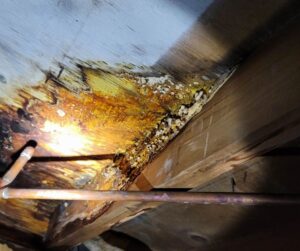Many people associate mold growth exclusively with damp, rainy conditions, but mold can thrive even in seemingly dry environments. Understanding how mold can grow without rain or excessive moisture is crucial for maintaining a healthy home, especially in unexpected places like desert climates.
Mold Growth Without Rain or Moisture
-
Humidity and Condensation Even in dry climates, indoor humidity can create favorable conditions for mold growth. Daily activities such as cooking, showering, and even breathing contribute to indoor humidity. Without proper ventilation, this moisture can condense on cool surfaces like windows, walls, and pipes, providing the dampness mold needs to grow.
-
Leaky Pipes and Appliances Mold can develop from hidden water sources like leaky pipes, appliances, or roofing. A slow, undetected leak can create a moist environment behind walls, under floors, or in ceilings, allowing mold to flourish out of sight.
-
Poor Ventilation Insufficient ventilation can trap moisture indoors, particularly in areas like bathrooms, kitchens, and basements. When air doesn’t circulate properly, humidity levels rise, creating ideal conditions for mold growth. This issue is prevalent in homes with tightly sealed windows and doors designed for energy efficiency.
Mold in Semi-Arid/Mountain Climates
It’s a common misconception that mold can’t grow in mountain climates due to the arid conditions. However, mold can indeed thrive for several reasons:
-
Indoor Humidity In Semi-Arid climates, people often rely on air conditioning to stay cool. While air conditioning reduces humidity, it can also create condensation on cooling coils and ducts if not properly maintained. This condensation can lead to mold growth within HVAC systems and spread throughout the home.
-
Flash Flooding Mountain areas are prone to occasional flash floods, which can quickly introduce significant amounts of moisture into homes. Even after the visible water has receded, residual moisture can remain in building materials, leading to mold growth if not thoroughly dried and treated.
-
Irrigation Systems Many Denver-area homes use irrigation systems to maintain landscaping. Improperly installed or leaking irrigation systems can introduce water into areas around the home’s foundation or crawl spaces, promoting mold growth.
Preventing Mold Growth
-
Maintain Low Humidity: Use dehumidifiers and ensure proper ventilation in high-humidity areas like bathrooms and kitchens.
-
Regular Inspections: Check for and repair any leaks in plumbing, roofing, and appliances promptly.
-
HVAC Maintenance: Keep air conditioning units and ducts clean and well-maintained to prevent condensation buildup.
-
Waterproofing: Use waterproof materials and sealants in areas prone to moisture exposure, such as basements and crawl spaces.
For more detailed information on mold growth and prevention, you can refer to the authoritative source provided by the Centers for Disease Control and Prevention (CDC).
Understanding that mold can grow without rain or visible moisture is key to preventing its development. By staying vigilant and addressing potential sources of moisture, you can protect your home and health from the harmful effects of mold, even in the driest climates.
